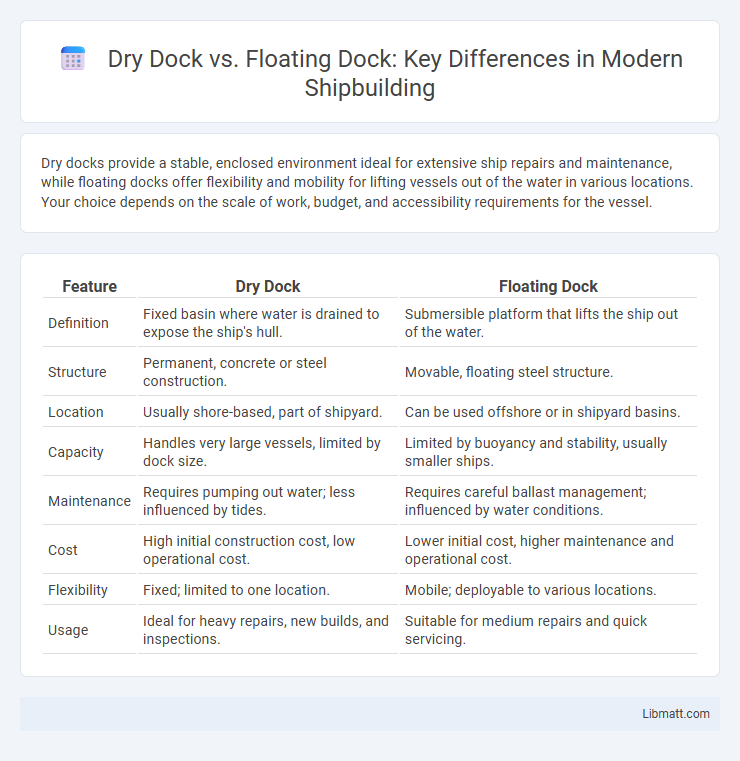Dry docks provide a stable, enclosed environment ideal for extensive ship repairs and maintenance, while floating docks offer flexibility and mobility for lifting vessels out of the water in various locations. Your choice depends on the scale of work, budget, and accessibility requirements for the vessel.
Table of Comparison
| Feature | Dry Dock | Floating Dock |
|---|---|---|
| Definition | Fixed basin where water is drained to expose the ship's hull. | Submersible platform that lifts the ship out of the water. |
| Structure | Permanent, concrete or steel construction. | Movable, floating steel structure. |
| Location | Usually shore-based, part of shipyard. | Can be used offshore or in shipyard basins. |
| Capacity | Handles very large vessels, limited by dock size. | Limited by buoyancy and stability, usually smaller ships. |
| Maintenance | Requires pumping out water; less influenced by tides. | Requires careful ballast management; influenced by water conditions. |
| Cost | High initial construction cost, low operational cost. | Lower initial cost, higher maintenance and operational cost. |
| Flexibility | Fixed; limited to one location. | Mobile; deployable to various locations. |
| Usage | Ideal for heavy repairs, new builds, and inspections. | Suitable for medium repairs and quick servicing. |
Introduction to Docking Systems
Dry docks are specialized structures designed to facilitate the repair, maintenance, and construction of ships by draining water to expose the hull. Floating docks offer a versatile alternative by submerging to allow vessels to float in and then rising to lift ships out of the water for inspection or repairs. Your choice between these docking systems depends on factors such as vessel size, location, and specific maintenance needs.
What is a Dry Dock?
A dry dock is a specialized structure used for the construction, maintenance, and repair of ships by allowing the vessel to be lifted out of water. It typically consists of a basin that can be flooded to let a ship enter, then drained to expose the hull for inspection and work. Your vessel benefits from the stable, dry environment a dry dock provides, enabling thorough maintenance and structural repairs.
What is a Floating Dock?
A floating dock is a type of platform that remains buoyant on the water's surface, designed to lift vessels out of the water for maintenance and repairs without requiring a permanent dry dock structure. Unlike dry docks, which are fixed installations, floating docks can be relocated and adjusted to accommodate various ship sizes through ballast control systems. They are essential for shipyards and marinas where versatility and mobility are critical for servicing different types of watercraft.
Key Differences Between Dry Dock and Floating Dock
Dry docks are fixed structures designed to hold vessels securely while water is drained, allowing complete access to the ship's hull for maintenance and repairs. Floating docks, by contrast, are portable platforms that can be submerged to receive a vessel and then raised to lift it out of the water, offering flexibility and ease of relocation. Your choice between these two depends on factors like size, cost, and the scope of repair work needed.
Advantages of Dry Docks
Dry docks offer superior stability and controlled environments for ship repairs and maintenance, enabling precise inspections and structural work. They provide easy access to the vessel's hull, ensuring comprehensive cleaning, painting, and welding tasks that floating docks cannot match. Your ship benefits from reduced downtime and enhanced safety during extensive overhauls in dry dock facilities.
Advantages of Floating Docks
Floating docks offer exceptional versatility by accommodating a wide range of vessel sizes and types, making them ideal for diverse maritime operations. Their mobility allows you to relocate the dock as needed, enhancing operational flexibility and reducing dependency on fixed infrastructure. Maintenance and repairs can be conducted efficiently in various locations, minimizing downtime and operational costs compared to traditional dry docks.
Limitations of Dry Docks
Dry docks face limitations such as size constraints, restricting the maximum vessel length and width they can accommodate, which impacts their suitability for very large ships. They require significant infrastructure investment and often have longer preparation times compared to floating docks. Your project may demand flexible scheduling and varied ship sizes, making floating docks a more adaptable choice in many cases.
Limitations of Floating Docks
Floating docks face limitations including size constraints that restrict the maximum vessel length and weight they can accommodate. Stability issues arise in rough sea conditions, limiting their use to calm or sheltered waters. Maintenance complexity increases since floating docks require regular ballasting and are vulnerable to corrosion and mechanical wear due to constant water exposure.
Choosing the Right Docking Solution
Selecting the right docking solution depends on vessel size, maintenance needs, and available infrastructure. Dry docks provide a stable, enclosed environment ideal for extensive repairs and hull inspections, while floating docks offer flexibility and quicker deployment for smaller vessels. Evaluating your ship's specifications and operational requirements ensures optimal performance and cost-efficiency in docking.
Conclusion: Dry Dock vs Floating Dock
Dry docks provide stable, land-based platforms ideal for extensive ship repairs and maintenance, offering predictable conditions and enhanced safety. Floating docks offer flexibility, enabling vessels to be serviced in various locations without requiring permanent infrastructure. Selecting between dry dock and floating dock depends on factors like project scope, location, vessel size, and logistical requirements.
Dry dock vs floating dock Infographic

 libmatt.com
libmatt.com